

The Indian religious tradition conceives of the divine feminine. In the uproar over the patriarchal prejudice that is said to infest Indian scriptures, a basic fact is lost sight of. No other living religious tradition in the world presents such a continuos and richly diverse record from the prehistoric times of worshipping the Divine as Feminine.
| A lot of writers who were inspired by the Hindu goddesses and who carried out investigation in this
area were seeking answers as to how to make sense of a tradition that worships a goddess who chops off her own
head, yet another who straddles her consort on a funeral pyre and another who is happy when she is given polluted
offerings. Being intensely individualistic, this form of worship is very different from the Vedic and Puranic sacrificial ceremonies. This group of goddesses presents a veritable "anti-model" for women, quite the opposite of a devoted housewife. In them the predominant theme is the oxymoronic coupling of death and mating, with the goddess almost invariably naked and in the dominant position. It is also said that the sacrifices these goddesses demand are invariably male victims. |
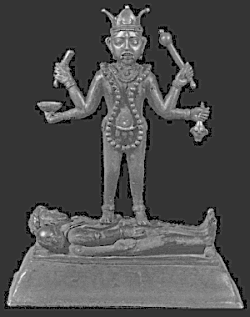 |
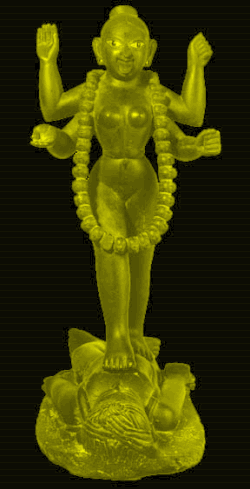 |
None of the Western scholars who have done research on these grounds have noted that the earliest
hymn devoted to a goddess occurring in the Rigveda is the only one composed by a woman: the seer Vak daughter of
rishi Ambhrin. This oldest mantra is also the most sublime of all invocations to the Divine Feminine. Vak, experiencing the Supreme Goddess, Adi Shakti, as her Self declaims, "It is I who, creating the universe and all worlds, wholly pervade them like the wind. Though I transcend the heavens and this earth, yet by my glory have I manifested creation." It is perhaps this sublimity that one seeks for in the Tantric vision and is left baffled and bewildered. Actually, this group spans the spectrum from the gradual horripilatingly dreadful to the sublime with its celebration of Chinnamasta at one end and Kamala at the other. The concept of Kamala comes after Tripura Sundari, the beauty of the three worlds celebrated in the Lalitha Sahasranamam, whose symbol is the ShriChakra. Bhuvaneshwari, whose body is the world, symbolised by the Inverted Triangle and Matangi, who insists upon being worshipped with offerings of leftover food. These three are represented as lovely maidens, the latter two appearing without any consort while Lalitha appears seated upon a reclining Shiva. |
| In the Lalitha Sahasranamam the Divine Mother's name is chanted a thousand times and each time the
name given to her is a different name. She is said to be pleased when she is called a "Mother". The chanting of "OM" is said to create such vibrations in air that slowly and gradually reaches GOD. The Lalitha Sahasranamam starts with: "OM...Shri Mata Shri Maharagi Srimad Simhasaneshwari Chitagni Kunda Sambootam Deva Karya Samoodyadatam." The other Mahavidyas are quite independent of Lord Shiva and their very manifestation is in defiance of him. Dhumvanti appears as a widow, consort-less, originating, like Bagalamukhi, in Sati swallowing Shiva when he would not assuage her hunger. Despite being a widow, the hymn invoking her makes her the creatrix of dance and enjoyer of erotic activity and liquor. |
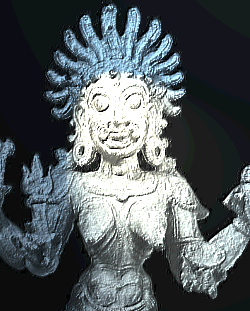 |
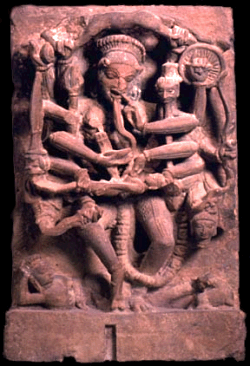 |
Each Mahavidya is a facet of the multi faceted Great Goddess, each containing all the others. This
is revealed in the invocatory verses addressed to any of them, which usually ascribe to her the names of the many
of the other nine. In Devi Purana Shiva invokes the Supreme Shakti of the eight Vidyas to destroy Subal and Dundubhui
at the request of Vishnu and the other gods. Knowing very well that weapons would be ineffectual, she discards her youthful form and becomes aged over hundred, withered, networked with veins, sunken eyes, pale lips, snake on the head, left hand on the left thigh, right hand on her back, gaping mouth cavern, limbs a tremble , encircled by the eight Vidyas astride ox, lion, elephant, peacock, garuda, bear, black-spotted deer. |
| The Vidyas dwell specially with women as clan-deities. They are established with gopis and tribals
and in Hastinapur, Ujjaini, Kamakshya, Kishkindaya, Bhot, Koshala, Raadh, Mahodaya, Vidisha and Jalandhar. This
crone obstructs Sharabh danav's way, telling him to lie with her and not discard her as old. The moment he holds
her hand to lift her, he falls dead. Another version in this Purana narrates that after Parashurama brought Kalika from Yashoda beside the northern sea and established her in Ayodhya, from her nine Durgas emerged and were established in Mahodaya. Devi Purana speaks of her form as Vaivasvati, riding a buffalo, with boar-like face, drinking from a skull and holding a staff. As Aghora she has a terrifying face wearing a lion skin and deerskin, necklace of heads and a skull in hand. As Vikata she rides a camel, has huge hands holding noose and staff, a terrifying mane, black sandal on body and fish for her food. Thus, the ten Mahavidyas are by no means unique. Their multiform exist in the nine Durgas, the eight vidyas, and the seven martikas (sometimes sixteen and even ninety-two in the Vana Parva of Mahabharata) |
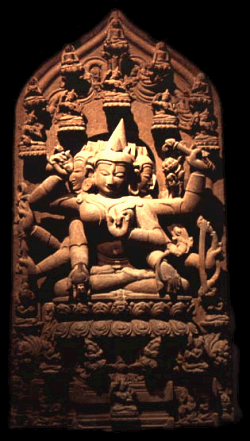 |
.
 |
The Yogic Vision of Tantra, is to see the adorable mother behind all the passions of the lower nature.
The terrible repulsive forms of the Mahavidyas are worshipped precisely in order to train the tantric yogi systematically
to envision the divine mother even in what appears to be dark and disgusting in life. Thereby he grasps the key
to sublimate and master the forces of his own lower nature, rising spiritually by those very things which causes
manís downfall. However distorted by ego, every desire is in essence of some power of the immanent Divine. Sri Aurobindo put it so well in Savitri, none can gain heaven who has not passed through hell. Removing the distortion leads to each taking its proper place to perform its right function according to the Supreme Law of bliss infusing all creation. |
![]()